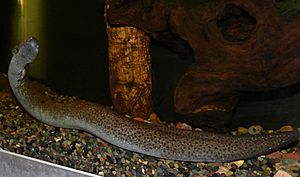Siren (zoology) facts for kids
Quick facts for kids Siren (zoology) |
|
|---|---|
 |
|
| A Siren intermedia | |
| Scientific classification |
|
| Kingdom: | Animalia |
| Phylum: | Chordata |
| Class: | Amphibia |
| Order: | Urodela |
| Family: | Sirenidae Gray, 1825 |
| Genera | |
|
†Habrosaurus |
|
Sirens (family Sirenidae) are a special type of aquatic salamander. They are unique because they keep some features from their larval (baby) stage even as adults. This is called neoteny. Sirens have very small front legs and no back legs at all. They also have feathery external gills on their necks, which help them breathe underwater.
You can only find sirens in the Southeastern United States and northern Mexico. While they mostly eat meat, they are the only salamanders known to eat plants too!
Contents
What are Sirens Like?
Sirens look a lot like eels. They can grow from about 25 to 95 centimeters (10 to 37 inches) long. Their tiny front legs are fully formed, even though they are small.
Even though they are neotenic, their baby gills are small at first. The gills only fully grow when the siren becomes an adult. This suggests that sirens might have come from ancestors that lived on land but had babies that lived in water. Like some other amphibians, sirens can move across land on rainy nights.
What do Sirens Eat?
Sirens are omnivorous, meaning they eat both plants and animals. Their mouths are special because they don't have many teeth. Instead, they have a hard, beak-like covering. They mostly eat worms, small snails, and shrimps. They also eat stringy algae, which is unusual for salamanders.
How do Sirens Survive Tough Times?
If a pond or water source starts to dry up, sirens have amazing ways to survive. They can shrink their gills until they barely work. They can also dig into the mud and create a protective cocoon of mucus around themselves. This helps them stay alive during dry periods. When they are in their cocoons, they use their small lungs to breathe.
Siren Reproduction
Sirens lay their eggs in water. Unlike most salamanders, male sirens take care of the eggs. They build nests for their offspring. This is called paternal care.
For example, in the Siren intermedia species, the male and female will circle each other. The male might gently rub or bite the female's side. Both will then turn onto their backs. It's believed that the female lays her eggs at this time, and the male fertilizes them. After the eggs are laid, the female leaves. The male then guards the eggs. A male siren might even guard more than one group of eggs. However, they are known to bite females who try to enter their nesting area.
This type of paternal care is important for understanding how salamanders have evolved.
Types of Sirens
The siren family (Sirenidae) includes five groups, called genera. Three of these groups are now extinct, meaning they no longer exist. Two groups still have living species today.
- Genus †Habrosaurus (extinct)
- †H. dilatus
- †H. prodilatus
- Genus †Kababisha (extinct)
- †K. humarensis
- †K. sudanensis
- Genus †Noterpeton (extinct)
- †Noterpeton bolivianum
- Genus Pseudobranchus (dwarf sirens)
- †P. robustus
- †P. vetustus
- P. axanthus (southern dwarf siren)
- P. striatus (northern dwarf siren)
- Genus Siren (sirens)
- †S. dunni
- †S. hesterna
- †S. miotexana
- †S. simpsoni
- S. intermedia (lesser siren)
- S. lacertina (greater siren)
- S. nettingi (western siren)
- S. reticulata (reticulated siren)
- S. sphagnicola (seepage siren)
See also
 In Spanish: Sirénidos para niños
In Spanish: Sirénidos para niños

